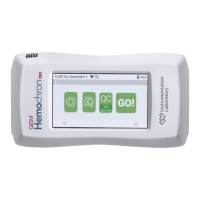8 - Centralized Conguration Manager(CCM) Software
88 / 112
000HZ6006EN.US • 02 • GEM Hemochron 100 Operator Manual
Setting Description
EQC Lockout Control (Continued)
Interval (1–1080)
Hours
Specify the period of time until the EQC Interval expires.
When the EQC Interval expires, patient test lockout occurs, preventing
Operators
from
running patient tests.
A
Supervisor
can congure the instrument so that after the EQC Interval expires,
Operators
are allowed to run as many as 240 additional patient tests. This postpones
lockout. See the description for the eld labeled
“Maximum Patient Tests Allowed
After EQC Expiration (0–240)”
.
When the additional patient tests have been run, the next time an
Operator
tries to run
a patient test, lockout occurs. A
Supervisor
must clear the lockout.
Start Time
(HH:MM) (24 hr)
The time of day that the EQC Interval starts running. For information about the
EQC Interval, see the description for the eld labeled
“Interval (1–1080) Hours”
.
The instrument time is automatically populated by default. Enter the value in 24 hour
time format (e.g., for
7:00 pm
, enter
19:00
).
Start Date The date that the EQC Interval starts running.
EQC Failures
EQC Failure
Limit (0–9)
The number of additional failed EQC tests that
Operators
are allowed to run before
QC lockout.
By default, if an EQC test fails,
Operators
can run 1 more EQC test. If the EQC test
fails, lockout will occur.
A
Supervisor
can congure the instrument so that
Operators
are allowed to run as many
as 9 additional failed EQC tests after the rst test fails. This postpones lockout.
To prevent
Operators
from running any additional failed EQC tests, enter
0
(zero). The
rst time an EQC test fails, lockout will occur.
If additional EQC test failures are allowed, the value in the eld labeled
“EQC Failure
Count”
is incremented each time an additional EQC test fails.
EQC Failure
Count
A counter that displays the number of additional failed EQC tests that
Operators
have
run. This value is read-only.
After the rst EQC test fails, the counter is incremented each time an additional
EQC test fails. The counter will be cleared (reset) when the
Operator
runs a successful
EQC test.
A
Supervisor
can clear this value by selecting Yes in the eld labeled
“Clear EQC
Failure Count”
. The counter will be cleared (reset) when conguration data is sent to
the instrument.
For more information, see the description for the eld labeled
“EQC Failure Limit (0–9)”
.
Clear EQC
Failure Count
Choose whether to clear (reset) the counter that displays the number of failed
EQC tests that
Operators
have run:
• No – Do not clear the counter.
• Yes – Clear the counter.
When Yes is selected, the counter labeled
“EQC Failure Count”
will be cleared (reset)
when conguration data is sent to the instrument.
Internal EQC
NOTE: When EQC is Required (Yes is selected in eld labeled “EQC Required”), it can be congured
using the following default features (optional):
Level 1 Limit Select 120 seconds.
Level 1 Range
Low
The expected low range for Level 1. This value is read-only.
Level 1 Range
High
The expected high range for Level 1. This value is read-only.
Level 2 Limit Select 300 seconds or 500 seconds.
Level 2 Range
Low
The expected low range for Level 2. This value is read-only.
Level 2 Range
High
The expected high range for Level 2. This value is read-only.

